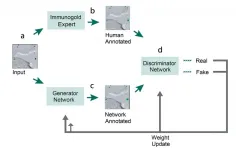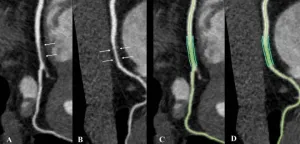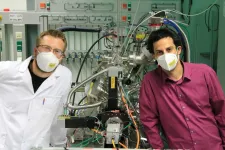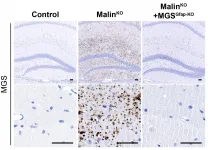(Press-News.org) With roughly 80% of jobs being sedentary, often requiring several hours of sitting stooped in front of a computer screen, neck pain is a growing occupational hazard. Smartphones and other devices have also caused people to bend their necks for prolonged periods. But is bad posture solely to blame?
In a recent study, researchers at Texas A&M University have found that while poor neck and head postures are indeed the primary determinants of neck pain, body mass index, age and the time of the day also influence the neck's ability to perform sustained or repeated movements.
"Neck pain is one of the leading and fastest-growing causes of disability in the world," said Xudong Zhang, professor in the Wm Michael Barnes '64 Department of Industrial and Systems Engineering. "Our study has pointed to a combination of work and personal factors that strongly influence the strength and endurance of the neck over time. More importantly, since these factors have been identified, they can then be modified so that the neck is in better health and pain is avoided or deterred."
The results of the study are published online in the journal END
Body mass index, age can affect your risk for neck pain
In a new study, Texas A&M researchers show that both personal factors and the time of day play a role in neck strength and endurance
2021-04-20
ELSE PRESS RELEASES FROM THIS DATE:
Explanations in online symptom checkers could improve user trust
2021-04-20
UNIVERSITY PARK, Pa. -- Have you recently turned to your mobile device or computer to find out if your cough, sniffle or fever could be caused by COVID-19?
The online symptom checker you used may have advised you to stay home and call your medical provider if symptoms worsen, or perhaps told you that you may be eligible for COVID-19 testing. But why did it make the recommendation it did? And how should you know if you can trust it?
Those are questions that researchers at the Penn State College of Information Sciences and Technology recently explored through a project in which they augmented online symptom checkers by offering explanations of how the system generated its probable diagnoses and suggestions ...
Gold digger: Neural networks at the nexus of data science and electron microscopy
2021-04-20
From sample preparation to image acquisition, electron microscopy (EM) requires precise and time-consuming steps to produce the clarity and detail needed to visualize small cell structures with high resolution. Moreover, once EM images are created, extracting the biological information out of them through analysis can be an even more laborious and time intensive task. Especially because current EM analysis software often requires the skilled eye of a scientist to manually review hundreds of images.
With a bit of ingenuity and the application of cutting-edge neural networks, an interdisciplinary team of scientists at the Max Planck Florida Institute for Neuroscience (MPFI) have created a new ...
Noncalcified coronary plaque burden higher in people with HIV
2021-04-20
OAK BROOK, Ill. - People living with human immunodeficiency virus (HIV) and without known cardiovascular disease have two to three times the noncalcified coronary plaque burden of non-HIV healthy volunteers, according to a study from Canada published in Radiology. Researchers said the results underscore the importance of a heart-healthy lifestyle in people living with HIV.
HIV/AIDS emerged as a major public health crisis in the 1980s. Disease-related mortality peaked in the mid-1990s and has been dropping since, thanks in large part to antiretroviral therapy, which does not cure the disease but helps control it.
Today, people ...
Base editors flex sights on sickle-cell disease
2021-04-20
Researchers at Beam Therapeutics have developed a redesigned base editor that shows considerable promise in directly repairing the single-base mutation that causes sickle-cell disease (SCD). Many strategies are being pursued to harness genome editing approaches including CRISPR to treat patients with SCD and related hemoglobinopathies. The most advanced method in the clinic involves targeting an upstream regulatory pathway to switch on expression of the fetal hemoglobin gene but does not target the SCD mutation directly.
Writing in the April issue of The CRISPR Journal, a team at Beam Therapeutics, led by Ian Slaymaker and Giuseppe Ciaramella, describe the successful ...
A gene finding links severe canine juvenile epilepsy to mitochondrial dysfunction
2021-04-20
In a study conducted at the University of Helsinki, researchers found a cause for severe epilepsy resulting in death in Parson Russell Terrier puppies at a few months of age. A change in the PITRM1 gene can lead to a dysfunction of mitochondria, the cellular energy pumps. Concurrently, amyloid-β accumulation and widespread neurodegeneration associated with Alzheimer's disease were identified in the puppies' brains. Changes to the PITRM1 gene in humans also cause a severe but slowly progressing brain disease.
Some Parson Russell Terrier puppies were seen to suddenly develop epileptic seizures at 6 to 12 weeks of age. The disease progressed very rapidly, in a matter of hours in the worst cases, to a situation where the seizures were continuous and unresponsive to medication.
"All ...
Review summarizes known links between endocrine disruptors and breast cancer risk
2021-04-20
Exposure to certain endocrine-disrupting chemicals could elevate the risk of breast cancer, according to a new comprehensive systematic review of epidemiological research. However, for many chemicals, evidence is inconsistent or still limited. The review was carried out by researchers at the universities of Hong Kong and Eastern Finland and published in Critical Reviews in Food Science and Nutrition.
Endocrine-disrupting chemicals (EDCs) can interfere with the body's hormonal system, also called the endocrine system, and are widely present in the environment. They originate from a variety of ...
New catalyst for lower CO2 emissions
2021-04-20
If the CO2 content of the atmosphere is not to increase any further, carbon dioxide must be converted into something else. However, as CO2 is a very stable molecule, this can only be done with the help of special catalysts. The main problem with such catalysts has so far been their lack of stability: after a certain time, many materials lose their catalytic properties.
At TU Wien, research is being conducted on a special class of minerals - the perovskites, which have so far been used for solar cells, as anode materials or electronic components rather than for their catalytic properties. Now scientists at TU Wien have succeeded in producing a special perovskite that is excellently suited as ...
"Molecular Tomographer" algorithm maps gene expression in space
2021-04-20
As we accumulate more and more gene-sequencing information, cell-type databases are growing in both size and complexity. There is a need to understand where different types of cells are located in the body, and to map their gene expression patterns into specific locations in tissues and organs. For example, a gene can be actively expressed in one cell while suppressed in another.
One way of mapping genes into tissues is a technique called in situ hybridization. Simply put, a target gene is tagged ("hybridized") with a fluorescent marker within the sections of the tissue it is located in (the "in situ" part). The sections are then visualized under a specialized microscope to see where the gene "lights up". Consecutive photographs of each section are then put together to generate a ...
Scientists at IRB Barcelona discover the cause of neurodegeneration in Lafora disease
2021-04-20
Lafora disease is an inherited neurodegenerative condition that initially develops with seizures in adolescence and evolves with progressive degeneration of the nervous system to death, about ten years after its onset. It is characterised by the accumulation of abnormal glycogen aggregates called Lafora bodies in the brain. There is currently no treatment for this condition, although some therapies are being tested in clinical trials.
Led by Dr. Joan Guinovart, emeritus professor of the University of Barcelona (UB) and also group leader of CIBERDEM, the Metabolic Engineering lab at IRB Barcelona has discovered that Lafora bodies that accumulate in glial cells, which are essential for the proper ...
2D nanomaterial MXene: The perfect lubricant
2021-04-20
You can lubricate a bicycle chain with oil, but what do you do with a Mars rover or a red-hot conveyor belt in the steel industry? Very special nanomaterials have now been studied by the TU Wien together with research groups from Saarbrücken (Germany), Purdue University in the USA and the Universidad de Chile (Santiago, Chile).
The material class of MXenes (pronounced "maxene") has caused quite a stir in recent years in connection with novel battery technologies. But it now turns out that they are also an excellent solid lubricant that is extremely durable and performs its task even under the most difficult conditions. These remarkable properties of MXenes have now been published in the renowned journal ACS Nano.
Like a stack of sheets of paper
Just ...
LAST 30 PRESS RELEASES:
Making lighter work of calculating fluid and heat flow
Normalizing blood sugar can halve heart attack risk
Lowering blood sugar cuts heart attack risk in people with prediabetes
Study links genetic variants to risk of blinding eye disease in premature infants
Non-opioid ‘pain sponge’ therapy halts cartilage degeneration and relieves chronic pain
AI can pick up cultural values by mimicking how kids learn
China’s ecological redlines offer fast track to 30 x 30 global conservation goal
Invisible indoor threats: emerging household contaminants and their growing risks to human health
Adding antibody treatment to chemo boosts outcomes for children with rare cancer
Germline pathogenic variants among women without a history of breast cancer
Tanning beds triple melanoma risk, potentially causing broad DNA damage
Unique bond identified as key to viral infection speed
Indoor tanning makes youthful skin much older on a genetic level
Mouse model sheds new light on the causes and potential solutions to human GI problems linked to muscular dystrophy
The Journal of Nuclear Medicine ahead-of-print tip sheet: December 12, 2025
Smarter tools for peering into the microscopic world
Applications open for funding to conduct research in the Kinsey Institute archives
Global measure underestimates the severity of food insecurity
Child survivors of critical illness are missing out on timely follow up care
Risk-based vs annual breast cancer screening / the WISDOM randomized clinical trial
University of Toronto launches Electric Vehicle Innovation Ontario to accelerate advanced EV technologies and build Canada’s innovation advantage
Early relapse predicts poor outcomes in aggressive blood cancer
American College of Lifestyle Medicine applauds two CMS models aligned with lifestyle medicine practice and reimbursement
Clinical trial finds cannabis use not a barrier to quitting nicotine vaping
Supplemental nutrition assistance program policies and food insecurity
Switching immune cells to “night mode” could limit damage after a heart attack, study suggests
URI-based Global RIghts Project report spotlights continued troubling trends in worldwide inhumane treatment
Neutrophils are less aggressive at night, explaining why nighttime heart attacks cause less damage than daytime events
Menopausal hormone therapy may not pose breast cancer risk for women with BRCA mutations
Mobile health tool may improve quality of life for adolescent and young adult breast cancer survivors
[Press-News.org] Body mass index, age can affect your risk for neck painIn a new study, Texas A&M researchers show that both personal factors and the time of day play a role in neck strength and endurance




